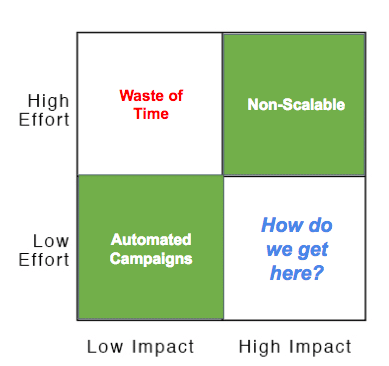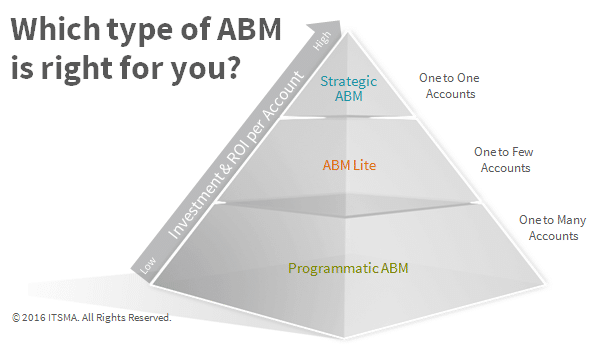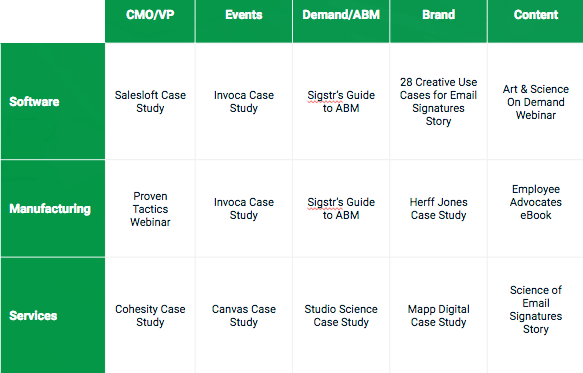Two years ago the average B2B buying committee was 5.4 people big. Skip to today, that number is 6.8, according to Harvard Business Review. On its face, that’s not a particularly big increase, but in the age of ABM where personalization and intense focus are everything, it’s a massive jump. At Sigstr, we target roughly 600 accounts at a given time, which means over the past two years, there are an additional 840 people we need to consider in all of our account-based sales and marketing efforts. We’ll let Maya Angelou tell you exactly why those 840 people matter so much.
All the feels
As marketers, we obsess over every single word on our website, in our email blasts, and in our tweets, but people will forget what was said. We stress endlessly over our event strategy, our swag, our follow-up campaigns, but ultimately those things will go unnoticed. However, the overall feeling you’re able to create when you demonstrate that you care about every individual through a beautifully orchestrated ABM campaign creates an indelible brand impression. That’s why every member of that buying committee matters. And as those buying committees scale, so too does our need to scale ABM content and campaigns.

The elusive ABM quadrant

The most impactful things your marketing team can do aren’t scalable and they’re seldom measurable.
Given all the time and money in the world, we could all put together phenomenal campaigns that filled our pipeline to the brim. Unfortunately, lack of resources is the biggest obstacle to success for B2B marketers, according to BrightTALK, which is why we all spend too much time in the lower left quadrant.
Occasionally sales and marketing will, with herculean efforts, pull together a top-right quadrant campaign. The holy grail for ABM marketers is how to land in that bottom right quadrant.
Choosing the right type of ABM

According to ITSMA, most teams start begin their ABM journey in the middle tier – “ABM Lite.” I would posit that the reason is because of bandwidth constraints. “Strategic ABM” requires large investments of both time and money. And “”Programmatic ABM” requires a heavy reliance on well-integrated (and typically expensive) tech stacks.
No matter where you are on your ABM journey, it’s imperative you consistently spend time in the “Strategic ABM” quadrant. The more time you spend there, the more you’ll develop the calisthenics necessary to make those efforts more scalable and more measurable. To be sure, this requires a little leap of faith and it may not even work the first time you run a super targeted and tightly orchestrated campaign. Here are some tips we’ve learned at Sigstr to help you get where you need to be.
Data, data, and more data
Doing some serious research on your top-tier accounts – and the people within them – can feel a little unnatural. Understanding the firmographics, initiatives, and brand values of your target accounts requires a lot of hard, manual work. Understanding the demographics, personalities, pain-points and passion-points of the individuals in each account requires even more hard work. At Sigstr, we take two hours a month enriching our account and contact data with information that we use to inform our personalized campaigns and to help our Sales team craft more engaging communications.
Create a content matrix
Here are some amazing stats from B2B Marketing: 84% of all buying committees have a “champion” and that champion holds 59% of the purchasing influence over their committee. Fully two-thirds of every champion cites “content, research, and expertise” as their primary consideration when making a purchase. Juxtapose that with this stat, from that very same study, that shows that 97% of champions have already made their purchasing decision before the committee is even formed!
That means B2B buyers are pulling together their coworkers, pouring over your content, and looking for your sales and marketing team to make them believe that the decision they’ve already made is the correct one. If you can provide a well tailored content experience that directly addresses their needs and roles, you’ll come off as an expert that the committee – and especially the champion – can trust.
How do you provide that tailored content experience? We obviously use Sigstr for it and align our content to the recipient’s persona (tracked in our CRM) and their sales stage (also tracked in our CRM). With these two known dimensions, Sigstr is able to intelligently and automatically insert a call-to-action banner in any email that any employee sends to the target account’s domain.
Sigstr is great for this because it persistently but passively promotes the right content, so you can be sure that your audience is seeing it but they’re not getting spammed. For those not lucky enough to have Sigstr though, here’s a workaround: Create a multi-dimensional content matrix that you can share with your sales team. Align your content to the dimensions most important to your company, for example, “Role” and “Industry”.

With your content organized this way, you take the guesswork out of sales’ hands and show where your content gaps are so you can write or repurpose for them. One other benefit is that it focuses the content to be the right piece for the right person. Don’t be that person that sends five blue links to content that may or may not be relevant – that’s a good way for none of your resources to be consumed.
The time is now
If you’re wondering when the right time to start scaling your ABM efforts is, the answer is now. Getting it right isn’t the most important thing, getting it started is. Put the contacts in your target accounts on a pedestal, become obsessed with the journey you’re about to take them on, and find out what happens. The more you do it, the better your ABM campaigns will be and the faster you’ll be able to execute them!